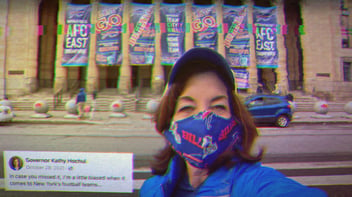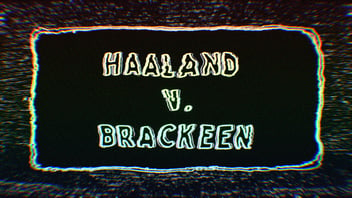Hochul’s “Gift.”
NY Governor Does it Again.
 Image Description: Kathy Hochul laughing and giving a gift. The background is a mudboil in the Tully Valley.
Image Description: Kathy Hochul laughing and giving a gift. The background is a mudboil in the Tully Valley.
Well. She’s done it again. I had other plans for this week, but in her pursuit of being an even more cold hearted villain than erstwhile governor Andrew Cuomo, New York Governor Kathy Hochul once again reveals her true feelings about Native rights. I know covering Hochul and Native issues might seem parochial, but as I’ve said before, what’s happening in New York is indicative of a longstanding pattern of abuse and dehumanizing behavior in this, and other countries, where treatment of indigenous communities is concerned.
While the headline of the story I’m about to tell you originally caught my attention, it was something buried deep within the story that really got me going. So here it is.
Tension With Hochul
This week, The New York Times decided to write about increasing tensions between Native tribes in New York and the Hochul administration. The thrust of the article was her veto late last year of the Unmarked Burial Protection Act, which “would have required builders to halt work after discovering ancient graves and associated artifacts, and to notify the local coroner or medical examiner. They would then call the state archaeologist, direct descendants of the dead and a new burial site review committee, who would help determine what to do next.”
The Times notes:
“Powerful business and real estate interests, who have donated hundreds of thousands of dollars to Ms. Hochul’s campaigns, raised objections about adding new layers of bureaucracy that could slow development. Aides said campaign contributions played no role in her decision to issue the veto.”
Of course it didn’t. A bicameral big “D” Democratic legislature pushed through legislation that had been working its way through committees for years, dying on her desk. Legislation from her own party.
A few important points before I get to the unbelievable part of all this. First, the reason the story caught my eye is because our friend and coffee supplier for our Native roasted line of coffee, Chief Harry Wallace, was quoted in the piece. So, I was obviously interested to see what he had to say. And I thought it curious that the Times would cover this veto now, since it happened months ago. That’s a critical piece of information, and I’ll get to why in a moment.
Anyway, Harry was basically quoted as saying that any hope of this administration being better than prior ones was set on fire because Hochul has clearly sided with monied interests since day one. We covered her dirty dealings to finance the Buffalo Bills stadium in a prior essay. As a reminder, Hochul took the extraordinary step to freeze the bank accounts of Seneca Nation members and businesses to compel them to part with half a billion dollars held in escrow and in dispute. I won’t relitigate that now, but it was a gangster move that even Cuomo didn’t have the temerity to pull off.
Not long after, she also thwarted legislation that would have granted recognition to the Montaukett Tribe on Long Island based on what the Times itself called “racist court rulings that remain in force today.”
So, this is a pretty devastating list in a relatively short tenure already. Held personal bank accounts of tribal members hostage, refused to consider recognition for a tribe in her state, vetoed a bill that would respect unmarked burial grounds of Native ancestors; oh, and she vetoed a hunting and fishing bill that would have allowed Natives the right to hunt and fish like most other states do. Hold that thought as well.
Okay, so let’s return to the Times for a moment and the fact that this wasn’t breaking news. There’s a key distinction that needs to be made between reporting on unfolding news in the moment and a reported piece. Good reporting means you take the party line and drill into it. Hochul, as the antagonist in this piece, offered the party line in defense of her actions. In a breaking news piece, it might be enough to let this stand. Instead, the Times accepts her response at face value and doesn’t probe any further; thereby leaving the reader with doubt in their mind as to her true intentions.
So here’s Hochul’s response, as reported by the Times:
“Ms. Hochul’s aides say she is anything but hostile to Native American groups in New York State. They pointed to several moves by the governor, including her role in returning land to the Onondagas, and plans to appoint a staff member solely dedicated to Native American affairs. And although she vetoed a hunting and fishing bill the tribes had pushed for, Ms. Hochul directed her administration to protect the rights of Native Americans whose hunting and fishing are protected by treaty law. Also under the Hochul administration, the State Department of Environmental Conservation created an Office of Indian Nation Affairs to ensure issues that are important to Native Americans were heard by the agency’s leaders.”
Now, let’s dissect this for a moment. We can dispense with the second part of their defense. Creating an office of Indian Affairs is performative nonsense that looks good in a press release and gets nothing done. That’s why there’s no follow up here. It’s just a bureaucratic response intended to divert your attention.
It’s the first part that really caught my eye because giving land back to tribes is something I follow pretty closely and I hadn’t heard of this, which was strange. But there was a link to this action, which somehow passes for reporting.
The Times link goes to a landing page on the New York State website with a press release about the land returning, calling it, “a historic agreement as part of the Onondaga Lake Natural Resource Damage Assessment and Restoration Program that will return more than 1,000 acres of scenic land to the Nation.”
Wow. 1,000 scenic acres. That’s impressive. Hang on. There’s more:
“As Natural Resource Trustees for the settlement with Honeywell International, Inc., the New York State Department of Environmental Conservation [DEC] and the Department of the Interior's Fish and Wildlife Service signed a resolution that directs Honeywell to transfer the title to more than 1,000 acres of open space in Central New York's Tully Valley to the Onondaga Nation—one of the largest returns of land by any state to an Indigenous nation.
And that’s when alarm bells went off in my head. Why was Honeywell, the DEC and the Interior Department all involved in giving back this land? The Times certainly didn’t ask this question, so I started poking around. And what I found would be shocking if it wasn’t so fucking par for the course.
The Onondaga Nation was party to the press release and announcement, so there was an air of credibility to the whole thing. But, as I’ve said before, there’s politics and there’s Native politics, and one should never assume anything with the latter. So, I searched for other reporting and came across an article in the Daily Orange, an independent non-profit publication run by students at Syracuse University. Here’s the lede from the article:
“When Honeywell International Incorporated signed over the land, which would eventually return to the Onondaga Nation in a historic 1,000 acre landback agreement, the only other party agreeing to the transfer’s terms was New York state. By the time the Onondaga Nation joined talks about the transfer, its conditions were already set.”
This is a departure from Onondaga joining in the announcement, so something didn’t square. The article quoted Joe Heath, the attorney for the Onondaga Nation and, turns out, he was pretty easy to find and very anxious to talk. And, boy, did I get an education.
The 1,000 Acre Truth
When I reached Heath in his office in Syracuse, he patiently walked me through the legal maneuvers involved in this so-called gift from New York State. Turns out, for more than 100 years, these acres and thousands more surrounding it—up to and including Onondaga Lake—were polluted so badly that they’re all national superfund sites. The land is contaminated pretty much beyond repair, which is why they can only attempt to remediate the land and, in the case of the lake, actually cap the lake bed like they do with landfills. In fact, the mercury contamination in the lake alone goes down 60 feet into the sediment.
Honeywell, and other corporations controlled or bought out by them over the years, have controlled this swath of land for over a century. And what they did to it is horrific. The creek that runs through the 1,000 acres of land being handed back to the tribe looks like, in Heath’s words, “coffee with cream.”
All of the fish are dead. There’s no life in the creek
The 1,000 acres is long like a rail car, and alongside the creek the hilly terrain that surrounds it was subject to decades of reckless salt mining that have created what Heath calls “a vacuum at the bottom of the valley the size of 35 football fields.” Sinkholes 600 feet across and 50 feet deep suddenly appear throughout the area. Fissures in the bedrock of the hill create what are known as “mudboils.”
What’s a mudboil, you might ask?
According to a geological survey from the Interior Department, mudboils are “volcano-like cones of fine sand and silt that range from several inches to several feet high and from several inches to more than 30 feet in diameter. Active mudboils are dynamic ebb-and-flow features that can erupt and form a large cone in several days, then cease flowing, or they may discharge continuously for several years.”
Hence, a dead creek that looks like coffee with cream.
These continuous discharges are a phenomenon found almost exclusively in Onondaga territory. The study said more needs to be done to understand this phenomenon, which first appeared in the 1890s. Now, I’m no scientist, but a quick glance at the timeline of Honeywell shows that one of its predecessors, The Solvay Process Company, began manufacturing something called soda ash in 1881.
And what’s soda ash, you might also ask?
Sodium Bicarbonate, better known as baking soda. The process involves blasting water through brine and limestone, mixing it with ammonia and, tada, you have baking soda.
It's a little more complicated than that, but suffice to say, these are all natural compounds; but the process of extraction and the chemistry required is harmful and dirty. The takeaway here is that this process is what created the massive sinkholes, the mudboils and the contamination in the area.
So, that’s the environmental catastrophe side of the story. Every part of this 1,000 acre parcel is fucked. It makes sense that Honeywell would want to dump this property and, considering the millions it has already spent in remediation of this and other sites, including the lake, one might think the job is done.
Well, according to Heath, it’s about 5% complete and whistleblowers have come forward to reveal that the capping of the lake bed has failed multiple times. And none of the remediation efforts have touched the mudboils, the sinkholes, landslides and chemicals that have spread throughout the valley.
The “Gift”
When the Hochul Administration so proudly announced this deal and it seemed like Onondaga was on board with the terms, there was a massive catch to the whole thing. The deal was announced in the summer of 2022, but the land still hasn’t transferred to the Onondaga Nation. Why? Because the terms of the deal include a consent decree that was negotiated among all of the parties except the nation.
That’s right, Honeywell, New York State and Biden’s Interior Department negotiated a two-part deal.
Part one was that all parties agreed that Honeywell’s remediation and mitigation efforts would be considered complete. And the second part, which is called the Natural Resource Damage and Assessment, froze the deal in place and indemnified Honeywell and all predecessors it acquired from lawsuits.
So, let’s recap.
New York State and the federal government are giving 1,000 acres of some of the most dangerous and hazardous land in the country, by their own estimation, back to the Onondaga Nation and telling them everything is their problem now and there’s no recourse against anyone ever. And the state also built in a provision saying that it still has supervision over whatever mitigation practices the tribe pursues, saying they have to do it in accordance with DEC standards. A corporation polluted land so badly it killed all the fish and wildlife. It’s hazardous to even walk there, let alone live there, because you might fall into a 600 foot sinkhole or get swept away in a mudboil. And even when they take the land back, they have to follow the instructions of the state that allowed the corporation to create this situation for more than 100 years.
And it gets better for Honeywell. Not only are they off the hook for any further environmental remediation, they also get to take the gift of land as a write off and are off the hook for paying property taxes, which robs Onondaga County of tax revenue since it comes off the rolls.
Now back to that other “hold that thought” moment. Hochul’s veto of Native hunting and fishing rights off Native territories. Once you understand the full context of just how badly the government, in direct collaboration with terrible corporations, has polluted Tribal lands, it’s that much more insulting to know that they’re also restricting Native people’s ability to do what they and their ancestors have done for centuries in these areas. They squeeze and squeeze until there’s nothing left. Give back land that never belonged to them after poisoning it beyond inhabitability. New York State, like so many others, are the worst squatters and houseguests ever.
There’s so much to be angry about in this, and every, story about Native and U.S. relations; most of it lost on the general public, who I would like to think would be horrified by this behavior. In Native country, this is just what it is. And it never improves, no matter how many commissions or committees are organized. It’s all mugging for the cameras. So I get it.
But I’m also disappointed in the both-sides reporting of the Times. It was so easy to take the next step and change the entire tenor of the story. To really pressure Hochul. Believe it or not, politicians still respond to the right type of media pressure. If the Times did half the job the Syracuse students at the Daily Orange did to lay this story out, Hochul would have to scramble. Instead, she gets a pass because it’s just Native land. Be grateful we even gave the land back. You should thank us.
Same as it ever was. Same as it ever was.
Here endeth the lesson.
Max is a basic, middle-aged white guy who developed his cultural tastes in the 80s (Miami Vice, NY Mets), became politically aware in the 90s (as a Republican), started actually thinking and writing in the 2000s (shifting left), became completely jaded in the 2010s (moving further left) and eventually decided to launch UNFTR in the 2020s (completely left).


